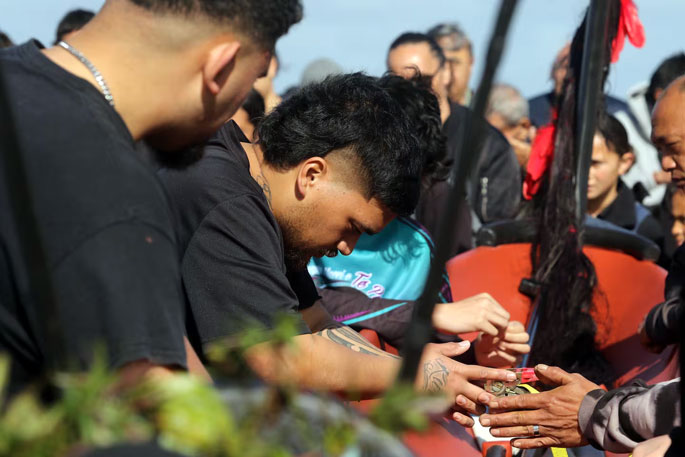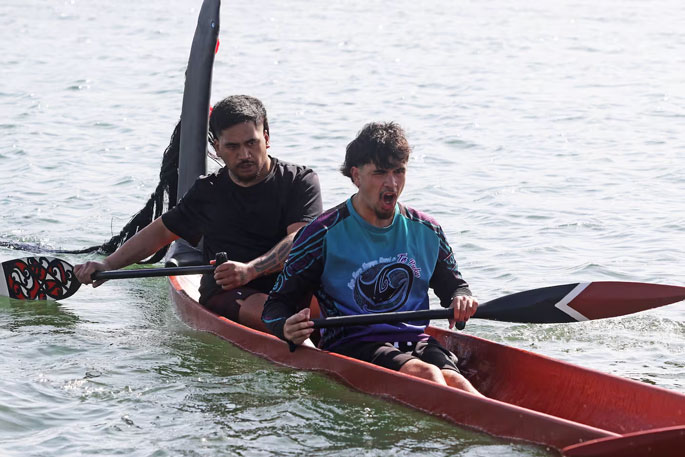For the first time in 100 years, a new waka was launched on the Kaituna River on Friday.
The waka Te Tauihu o te rangi was built at Makahae Marae over five months under the watchful eye of tarai waka (waka builder) Haimona Brown. He has been guiding Josh Roberts, Israel Hapi, Kahukura Williams, Elisha Ryan, Manahi McNeill, Horouta Corbett, Tahae Roberts and Tapua Robert through the build that has a wider purpose.
A hugely significant event, the waka launch is the culmination of a pilot project aimed at fostering kaitiakitanga (guardianship) and reconnecting whānau, hapū, iwi and the wider community to the Kaituna catchment through mātauranga Māori practices.
The programme — Ngā Niao o te Kaituna — is a combined initiative of Tapuika iwi and Makahae Marae, Ngā Kakano Foundation and NZ Landcare Trust.
Master carver Dean Flavell is kaumātua for the project and, as Makahae Marae chairman, was able to make the marae available.
He says the project is designed to offer the opportunity to teach another generation the skills required to build a waka. “With a toi whakairo [carving] background I understand the importance of sharing such traditional knowledge,” he says.
 Heads bowed for the karakia, blessing the waka, said by kaumātua Dean Flavell before the launch.
Heads bowed for the karakia, blessing the waka, said by kaumātua Dean Flavell before the launch.
“I also see and know the benefits of being trained in carving which can deliver additional skills and opportunities that can provide jobs in the future. If this is a skill that these young men can take with them in their life’s journey, then great.”
Ngā Kākano Foundation initiated a hui to discuss a programme which can deliver traditional skills through waka building with a focus on waiora tangata (personal well-being).
“We were asked if we would be able to provide a programme for young people to engage in and teach a traditional skill and we took on that challenge.”
A suitable place was already available at the marae.
“We happened to have just completed the new carvings for the centenary of the Makahae meeting house — the meeting house turned 100 years old in April - so we had all this tarpaulin structure up here and we thought, let’s put this to use and start building a waka in there.
That was when Haimona came on board.
“Waka building was identified as being an endangered culture and one of huge importance,” says Haimona.
But he says the waka is merely a vessel to help people reconnect with the awa (river) and that connecting with culture and improving the wellness of the Kaituna helps people improve their own wellness.
“If the Kaituna and its wellness is being improved, then the wellness in ourselves will be improved as well, and that’s why connecting with our identity, we pick up the wellness of ourselves.”
 The waka about to be launched.
The waka about to be launched.
Haimona says standing on a voyaging canoe had a profound influence on him.
“I was well and truly bitten when I first jumped on the waka and it really opened up my eyes to what was out there and I’ve been with the kaupapa for quite a long time now.”
He grew up in the area and felt it was important to be part of the programme.
“Because of the skills I’ve acquired and inherited and been taught, there is almost an obligation to foster it with my community down here.
“We are touching back with our culture to have a different outlook on the world and be good people.”
A desire to reconnect was also enshrined in the Tapuika Treaty of Waitangi settlement, enacted in 2014
Te Maru o Kaituna River Authority was created as part of the settlement. The authority is a co-governance partnership mandated to restore, protect and enhance the environmental, cultural and spiritual health and wellbeing of the Kaituna River.
It is made up of iwi representatives from Tapuika Iwi Authority Trust, Te Kapu Ō Waitaha, Te Pumautanga o Te Arawa Trust, Te Tāhuhu o Tawakeheimoa Trust and Te Komiti Nui o Ngāti Whakaue, and council representatives from the Bay of Plenty Regional Council, Rotorua Lakes Council, Western Bay of Plenty District Council and Tauranga City Council.
 Waka kaihoe (paddlers) Josh Roberts and Horouta Corbett.
Waka kaihoe (paddlers) Josh Roberts and Horouta Corbett.
“When we were talking with central government about the formation of a co-governance group for the river one of the aspirations was to be able to bring our people back onto the river and reconnect them,” says Dean.
“The issue that we have faced for the last 200 years was when our lands were confiscated in the mid-1800s, we as tangata whenua lost our connection and tribal practices with the many rivers within the catchment, in a sense this has largely contributed to our loss of identity as river people. Our hope is that through this programme we can help to rectify and re-establish this connection – through such future activities like tira hoe waka (journeys by waka).
“Under Te Maru o Kaituna, we have all the councils involved in that, we were able to talk to local council, Western Bay District Council, which has been really supportive.”
One of the roles of the authority is to identify where the historic places are, and how to connect with them.
“Our kaumātua elders [at Te Kahika Pa / Makahae Marae] used to tell us that on the Waiari, where the bridge is, that’s where all our canoes used to be.”
Before the roads were built, visitors to Te Puke would arrive at Maketū by sea, then travel along the Kaituna to Canaan’s Landing from where they would be brought up the Waiari by waka to go to Te Puke.
“So we thought, wouldn’t it be a great thing to be able to have a waka again, maybe not to do that, but to reconnect and also tell our stories?
“One of the things that we need to do ensure is that the next generations are told these pūrākau kōrero tawhito [stories from the old people] and transferring this knowledge to the next generation and that’s a role the marae provides.
 Tarai waka (waka builder) Haimona Brown (right) watches on as rangatahi from the programme and their supporters perform a haka.
Tarai waka (waka builder) Haimona Brown (right) watches on as rangatahi from the programme and their supporters perform a haka.
“So that’s the overall aspiration and our approach is year by year as resources allow. This is the pilot and with the wonderful outcome witnessed on Friday we feel this is the way forward.”
The programme is also in partnership with NZ Landcare Trust. It is a legacy project that falls under its Junior Landcare Programme, sponsored by the Bupa Foundation.
The trust’s Bay of Plenty Regional co-ordinator Tireni Ratema says her background in waterways and canoe and her relationships with the project’s leaders have been quintessential to the partnership.
“The project is essentially built on that relationship, trust and genuine passion and aroha for the kaupapa through personal commitments through canoe and waterways.”
The initial task was to listen to hapū and iwi and their aspirations to reconnect with their awa, the Kaituna catchment.
“Really, it’s being able to align NZLT values with those of the people at place such as Ngāti Tuheke, Makahae Marae, Tapuika and the wider rohe.
“Essentially by listening to their aspirations, there was clear synergy in terms of kaitiakitanga and the desire to reconnect people to water which is absolutely the main focus of the team at NZ Landcare Trust.”



0 comments
Leave a Comment
You must be logged in to make a comment.